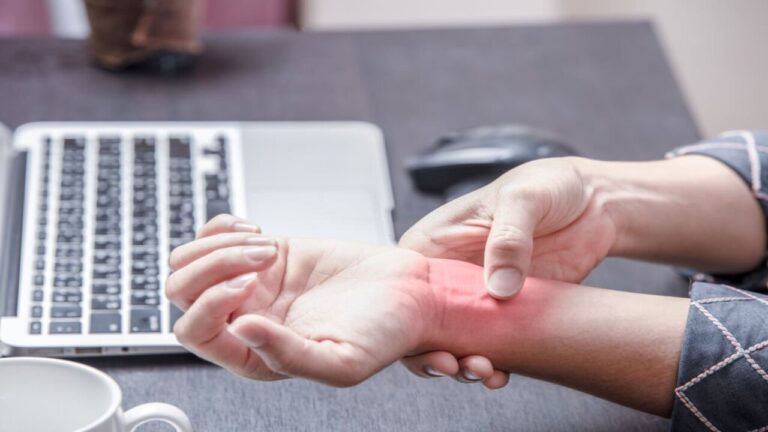You can find immediate relief for sciatic pain with ice packs, warm compresses, and over-the-counter pain relievers. However, you should consider whether you genuinely want a short-term solution. Many quick fixes may offer relief, but they do little to address the underlying cause of sciatic nerve pain.
One option for long-term relief and sciatic pain management is working with a chiropractor who can assess, diagnose, and treat your back injury while also providing relief for your chronic pain. At Naples Community Injury Center, our doctors have more than 60 years of combined experience helping patients with sciatica and other related conditions.
9 Options for Quick Relief from Sciatica Pain

Sciatic pain can be severe enough that it is more than just uncomfortable. It’s often disabling, preventing sufferers from enjoying activities or participating in the things they previously did. Many miss work or even struggle to run errands, prepare meals, or take care of their own daily activities.
When you need immediate relief, there are a few things you can try. Not all these options will work for everyone, but they could lessen or eliminate your pain.
- Stretching: Gentle stretching exercises can relieve pressure on the sciatic nerve. Examples are available online, or you can see a physical therapist to learn the best stretches for your sciatica.
- Heat and Cold Therapy: Applying a heating pad or cold pack helps reduce inflammation and provides temporary pain relief. This is a good option if you have back pain in addition to other symptoms.
- Over-the-Counter Pain Medications: Many people want to avoid using narcotic painkillers, but non-prescription pain relievers like ibuprofen (Advil, Motrin) or acetaminophen (Tylenol) alleviate sciatic pain for many people.
- Massage Therapy: Gentle massage relaxes tense muscles and improves blood flow to the area, relieving sciatic pain.
- Topical Treatments: For those who do not want to take over-the-counter pills, creams and ointments containing capsaicin or menthol provide temporary relief by numbing the area and reducing inflammation.
- Yoga or Pilates: These practices focus on strengthening and stretching the muscles, which can alleviate sciatic pain over time. Some yoga poses, such as downward-facing dog or child’s pose, are often particularly beneficial. A knowledgeable instructor may provide additional poses to address your pain.
- Supportive Pillows: Using a supportive pillow or cushion while sitting or sleeping reduces pressure on the sciatic nerve and alleviates discomfort.
- Rest: Sometimes, avoiding activities that aggravate the pain provides relief. However, you must balance rest with careful movement and stretching to prevent stiffness and muscle weakness.
- Seeing an Experienced Chiropractor: Chiropractic care realigns the spine and can relieve pressure on the sciatic nerve. This often provides quick pain relief as well as a long-term solution to address the underlying cause.
To ensure you understand your injury and receive treatment, you may want to see a doctor as soon as possible. A chiropractor will ensure you take the right steps to alleviate your pain based on your diagnosis and a comprehensive treatment plan.
How Can a Chiropractor Help Relieve My Sciatic Pain?
A chiropractor will assess your unique injury and needs and prescribe techniques to relieve sciatic pain. This is generally part of a comprehensive treatment plan for sciatica. Your plan might include:
Chiropractic Adjustments
The Naples Community Injury Center team uses manual manipulation techniques to realign the spinal column and improve mobility. Adjustments relieve pressure on the sciatic nerve, reducing pain and discomfort. For some patients, this can occur almost instantly.
Spinal Decompression Therapy
This therapy involves gently stretching the spine to relieve pressure on the discs and nerves. Spinal decompression is often particularly beneficial for patients who have herniated discs or spinal stenosis that causes or contributes to their sciatic pain.
Soft Tissue Therapy
Chiropractors prescribe soft tissue techniques such as massage, myofascial release, or other therapies to address muscle tension. Our team provides a wide range of complementary therapies to help patients manage pain while they undergo treatment. This could allow you to avoid using painkillers.
Posture Correction
Poor posture often contributes to sciatic pain by placing excessive strain on your spine and surrounding soft tissue. Chiropractors and physiotherapists guide proper posture and ergonomic techniques to alleviate this pressure and eliminate the resulting pain.
Nutritional Counseling
Inflammation and nutritional deficiencies can exacerbate sciatic pain. Chiropractors offer advice on dietary changes and supplementation to reduce inflammation and support overall nerve health as appropriate.
Lifestyle Modifications
Chiropractors educate patients about lifestyle factors affecting sciatic pain, such as weight management, stress reduction, and proper ergonomics at work.
Physical Therapy
Physical therapy techniques used as part of a comprehensive treatment plan for sciatica include targeted exercises, stretching, and strength building.
Rehabilitation
Once they address your underlying injury, your chiropractor will prescribe specific exercises to strengthen the muscles in your lower back and improve flexibility. These exercises can help prevent future episodes of sciatic pain and promote long-term spinal health.
By combining these approaches into a personalized, comprehensive treatment plan, chiropractors aim to address the causes of your sciatic pain and provide long-lasting relief. Your treatment plan will vary depending on the severity of your symptoms, any underlying health conditions, and your current fitness level.
Before I Try Options for Relief, How Do I Know If I Have Sciatica?
Sciatica usually causes distinct symptoms that differentiate it from other types of back or leg pain. The common signs and symptoms associated with sciatica include:
Pain
Sciatic pain typically radiates down the sciatic nerve, which runs from your lower back through your rear, outside your thigh, and down your leg. The pain can vary in intensity and may feel sharp, shooting, or burning. It often affects only one side of the body.
Numbness and Tingling
Sometimes, the most disabling symptom of sciatica is numbness, tingling, or a pins-and-needles sensation in your leg and/or foot. You could have numbness, tingling, and burning alongside pain or without it.
Weakness
Sciatica often causes weakness in the leg, making it difficult to move it properly or bear weight. You may notice difficulty with walking, standing from a seated position, or climbing stairs. Depending on the affected leg, driving might be difficult for some people.
Worsening Symptoms
Certain movements or positions—sitting for prolonged periods, bending forward, or holding heavy objects away from your body—may exacerbate sciatic pain. Sometimes, changing positions can provide temporary relief.
Back Pain
While the most common symptom of sciatica is pain radiating down one leg, it originates from a problem in the lower spine. For this reason, you may also experience low back pain or stiffness.
If you have any of these symptoms, it is time to talk to your doctor or a chiropractor for a proper assessment and diagnosis. Chiropractors regularly see a wide range of musculoskeletal conditions, including sciatica. They will perform a physical exam, review your health history, and order diagnostic tests to confirm the diagnosis. Then, they’ll create a personalized treatment plan just for you.
What Should I Expect If I Go to Naples Community Injury Center for My Sciatica?
At Naples Community Injury Center, each patient receives a personalized treatment plan to address their injuries, manage their symptoms, and treat the underlying cause. While each plan is different, we adhere to the same process for everyone. This process includes:
An Initial Intake Examination
You should expect your first appointment to take longer than your future visits. We will assess your condition, examine you, prescribe medical imaging as necessary, and diagnose the cause of your sciatic pain. Only then will we develop a treatment plan.
Your Personalized Treatment Plan
Your treatment plan will depend on your unique situation and will consider your injuries, current health, goals, and several other factors. Still, you may begin treatment the same day. We aim to provide relief as soon as possible.
As you progress through your plan, we will continue to assess your progress and alter the plan as necessary to ensure you get the best results possible.
Physiotherapy
Our in-house physical therapists provide pain management, symptom reduction, and treatment through gentle guided exercises, stretching, and strength exercises. This is often a crucial part of sciatica treatment because these therapies address strength imbalances and aid in recovering flexibility.
Rehabilitation
As your symptoms diminish, our focus turns to rehabilitation. Our goal is for you to leave our care healthier than before your injury. This is the best way to prevent future occurrences of sciatica.
What Should I Do If I Need Help for My Sciatic Pain in Naples, FL?
Contact our team today for your initial intake exam. We may be able to get you in quickly and provide relief for your sciatic pain. Let our doctors prescribe a comprehensive treatment plan tailored to your specific needs. We will work together to alleviate your symptoms and improve your spinal health.
Call Naples Community Injury Center for Your Initial Intake Appointment
Naples Community Injury Center is now accepting new patients for sciatica treatment at our Naples, Marco Island, and Estero clinics. We can answer your questions and help you make your initial appointment with our team. Contact us online or call us through our number.







